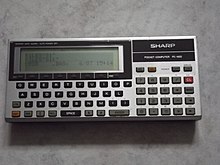Sharp PC-1600
Appearance
 | |
| Type | pocket computer |
|---|---|
| Manufacturer | Sharp |
| Calculator | |
| Entry mode | BASIC |
| Programming | |
| User memory | 16K |
| Firmware memory | 96K |
The Sharp PC-1600 was a pocket computer introduced by Sharp in 1986 as a successor to the PC-1500. The PC-1600 provided compatibility with its predecessor through the use of a slave CPU that could run assembly language programs targeting the older machine. It could also switch into a compatibility mode so that programs written for the single line display of the PC-1500 could work with the four line display of the PC-1600.
PC-1500 peripherals such as the CE-150 cassette interface were also supported.
Technical specifications
- SC7852 CMOS 8 bit microprocessor, equivalent to the Z-80A, 3.58 MHz[1]
- LH-5803 slave CPU compatible with PC-1500, 1.3 MHz
- LU57813P sub CPU, 307.2 kHz
- 96K ROM
- 16K RAM, expandable to 80K
- 26 column, 4 line LCD with a 5x7 character matrix
- 156x32 dot graphics
- Real time clock
- RS-232C interface
- Optical serial port
- Analogue interface for connection to sensors
- 390 g in weight with batteries
Accessories
- CE-1600M program module providing 32K of battery backed storage
- CE-1600P Printer/Cassette interface
- CE-1600F 2.5-inch double-sided pocket disk drive providing 64K of storage per side with CE-1650F media[2]
See also
References
- ^ Sharp PC-1600 Operation Manual, 1986.
- ^ "Model CE-1600F". Sharp PC-1600 Service Manual (PDF). Yamatokoriyama, Japan: Sharp Corporation, Information Systems Group, Quality & Reliability Control Center. July 1986. pp. 98–104. Archived (PDF) from the original on 2017-03-23. Retrieved 2017-03-23.
Further reading
- SHARP Taschencomputer Modell PC-1600 Bedienungsanleitung [SHARP Pocket Computer Model PC-1600 Operation Manual] (PDF) (in German). Osaka, Japan: Sharp Corporation. TINSG1031ECZZ. Retrieved 2017-02-27.
External links
- The Ultimate Pocket Computer Original product brochures and source for accessories
- Sharp PC-1600 site by Harald Richter German with sections in English and French
